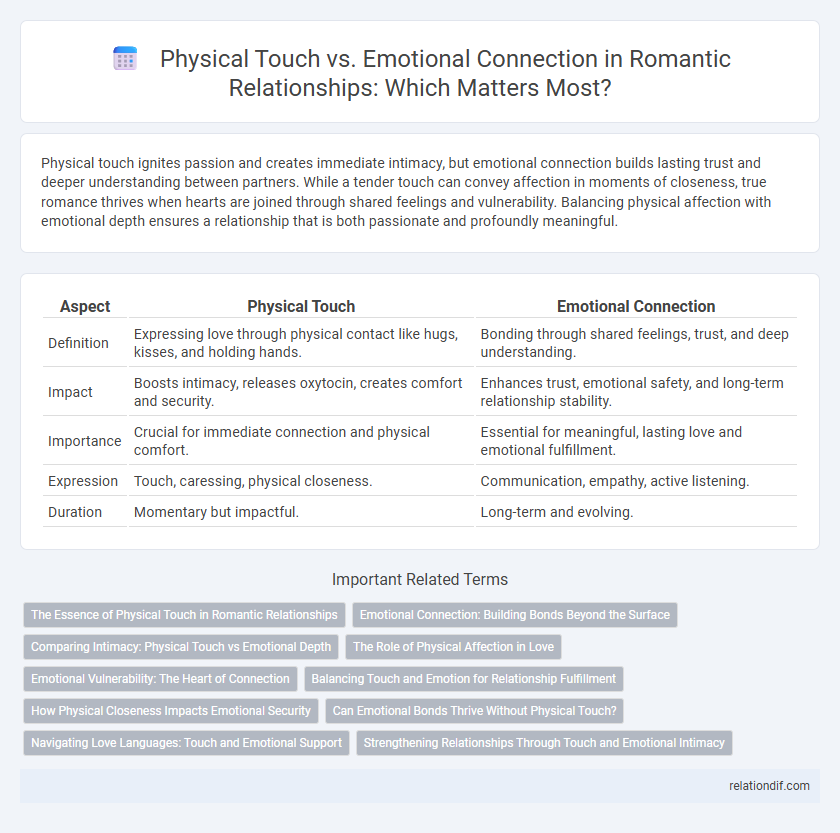Physical touch ignites passion and creates immediate intimacy, but emotional connection builds lasting trust and deeper understanding between partners. While a tender touch can convey affection in moments of closeness, true romance thrives when hearts are joined through shared feelings and vulnerability. Balancing physical affection with emotional depth ensures a relationship that is both passionate and profoundly meaningful.
Table of Comparison
| Aspect | Physical Touch | Emotional Connection |
|---|---|---|
| Definition | Expressing love through physical contact like hugs, kisses, and holding hands. | Bonding through shared feelings, trust, and deep understanding. |
| Impact | Boosts intimacy, releases oxytocin, creates comfort and security. | Enhances trust, emotional safety, and long-term relationship stability. |
| Importance | Crucial for immediate connection and physical comfort. | Essential for meaningful, lasting love and emotional fulfillment. |
| Expression | Touch, caressing, physical closeness. | Communication, empathy, active listening. |
| Duration | Momentary but impactful. | Long-term and evolving. |
The Essence of Physical Touch in Romantic Relationships
Physical touch serves as a powerful nonverbal language that deepens intimacy and strengthens the bond in romantic relationships. It releases oxytocin, often called the "love hormone," which fosters feelings of trust and affection between partners. Beyond emotional comfort, consistent physical contact can enhance relationship satisfaction and resilience during conflicts.
Emotional Connection: Building Bonds Beyond the Surface
Emotional connection in romance fosters deep trust, understanding, and intimacy that transcend physical interactions. This bond nurtures long-lasting relationships by prioritizing shared feelings, values, and meaningful communication. Couples who cultivate emotional closeness experience increased relationship satisfaction and resilience during challenges.
Comparing Intimacy: Physical Touch vs Emotional Depth
Physical touch in romance offers immediate intimacy through gestures like hugging, kissing, and holding hands, which stimulate oxytocin release and foster a sense of closeness. Emotional connection, however, builds deeper intimacy by sharing vulnerabilities, thoughts, and feelings that create trust and long-term bonding. While physical touch can spark attraction and comfort, emotional depth sustains meaningful relationships by nurturing understanding and empathy between partners.
The Role of Physical Affection in Love
Physical affection plays a crucial role in deepening romantic bonds by fostering trust and comfort between partners. Through gestures like hugging, holding hands, and gentle touches, individuals communicate love and reassurance beyond words, enhancing emotional intimacy. Consistent physical touch releases oxytocin, a hormone that strengthens attachment and promotes feelings of security and happiness in relationships.
Emotional Vulnerability: The Heart of Connection
Emotional vulnerability is the core of a true romantic connection, enabling partners to share fears, dreams, and insecurities without judgment. This openness fosters deep trust and intimacy far beyond physical touch alone. Couples who prioritize emotional connection often experience more fulfilling and resilient relationships, rooted in genuine understanding and empathy.
Balancing Touch and Emotion for Relationship Fulfillment
Balancing physical touch with emotional connection fosters deeper intimacy and lasting relationship fulfillment by addressing both partners' needs. Effective communication enhances understanding of tactile preferences, while expressing feelings cultivates emotional security and trust. Prioritizing these elements supports a harmonious bond that nurtures love and mutual satisfaction.
How Physical Closeness Impacts Emotional Security
Physical closeness enhances emotional security by releasing oxytocin, which strengthens bonding and trust between partners. Regular touch reduces stress hormones like cortisol, promoting a sense of safety and comfort in relationships. This tangible connection deepens emotional intimacy, making partners feel more valued and understood.
Can Emotional Bonds Thrive Without Physical Touch?
Emotional bonds can thrive without physical touch by relying on deep communication, trust, and shared experiences that foster intimacy and understanding. Studies in relationship psychology reveal that couples maintaining strong emotional connections through verbal expression and empathy often report high satisfaction levels despite physical distance. Virtual interactions and written correspondence can effectively sustain emotional closeness, highlighting the brain's ability to adapt to non-physical forms of connection.
Navigating Love Languages: Touch and Emotional Support
Physical touch serves as a powerful love language, offering comfort and intimacy that can deepen romantic bonds through hugs, hand-holding, and gentle caresses. Emotional connection, expressed through listening, empathy, and verbal affirmations, fosters trust and understanding that strengthen relationship resilience. Balancing physical affection with emotional support requires attunement to a partner's unique needs and communication style, ensuring love is conveyed in the most meaningful and nurturing manner.
Strengthening Relationships Through Touch and Emotional Intimacy
Physical touch, such as holding hands or gentle caresses, releases oxytocin, fostering trust and deeper emotional bonds in romantic relationships. Emotional connection strengthens communication and empathy, creating a supportive foundation that enhances intimacy. Combining physical touch with emotional closeness significantly improves relationship satisfaction and long-term stability.
Physical Touch vs Emotional Connection Infographic

 relationdif.com
relationdif.com